
Our Moral Endowment
Humans evolved with innate abilities that help us live together in diverse groups. Studies show that infants are born with a foundational appreciation of the minds of others. From a very early age, babies begin to demonstrate innate cooperative and helpful tendencies, a capacity to tell kindness from cruelty, a rudimentary sense of fairness and justice, and empathy and compassion for others.
Human beings are able to live all over the planet and in all conditions because we can adapt to and change our environment, developing different strategies for survival anywhere on earth; and because we have the ability to understand that different people have different ideas and experiences than ourselves, and we can learn from them and adapt to and with them.
The Advantages of Bipedalism

The advantages of bipedalism were many but, as a consequence, the female pelvis narrowed, and children had to be born “prematurely” – that is, earlier in their development compared with other animals. The more brain development that takes place once the offspring is born, the more adaptive the animal is. The human child is born with only 25% of adult brain size. And we are born with abilities that help us live in diverse groups.
A Sense of What Others Are Thinking and Feeling
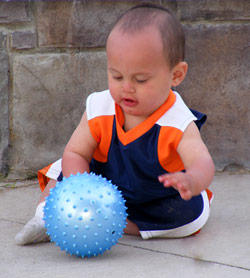
From a very young age humans have a foundational appreciation of the minds of others. Children as young as fifteen months old can think of the shapes around them as having emotions and wishes and projects that are distinct from their own. We have an innate ability to attribute mental states to ourselves and others which predict and explain behavior. Called theory of mind, this ability means that we can recognize, communicate, and manipulate mental states in others and reflect on our own.
As we know from studying our ape ancestors, other social animals can hunt, mate, nurture their young, recognize others and emotions in others, group together in hierarchies and make alliances—all without this theory of mind ability. But they cannot teach or tease others; they cannot trade with others, nor communicate ideas or complex emotions. Nor can they manipulate beliefs, know what someone else is thinking, or reflect on what they are thinking themselves; and they are not self-aware.
When they are awake and not hungry, [babies] prefer looking at a face and hearing a voice over anything else.
From the beginning of life, babies begin to cultivate this ability: when they are awake and not hungry, they prefer looking at a face and hearing a voice over anything else. At as young as fifteen months children understand false beliefs; from 18 months they exhibit inherent “mentalizing”: they pretend play, understand deception, intention, and implicit or false belief. By the age of five children can explain and predict behavior in others on the basis of their inner state: their intention, desires, beliefs, etc. This mentalizing ability increases our range of social behavior enormously; it allows us to accumulate cultural knowledge and transmit it by teaching. No other animal can do this.
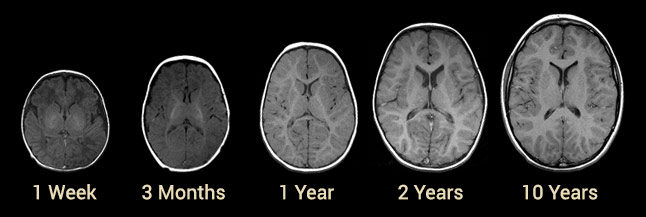
It’s generally known that the early years are the most important in a child’s development: this is the period where we identify our group, and develop our language and social behaviors. Although 90% of our brain growth takes place in the first three years of life, the human brain undergoes a lot more maturation and development over the next two decades. In contrast, the chimps brain is fully mature and developed at about age three. Until recently it’s been hard to tell what’s going on developmentally in the early years of our lives. For at least the first year the child is nonverbal, has very little physical control and is totally dependent on others for survival. Additionally, once she is verbal, she has no memory at all of what it was like to be an infant.

In March 2018 the BBC reported that the Babylab at Birkbeck College, London are able to measure brain activity at the cellular level, inside the mitochondria, thanks to a new technology called functional near infrared spectroscopy, or fNIRS. It will enable scientists to detect a whole range of neurological differences, long before the appearance of any outward symptoms.
“Behaviorally, you won’t be able to see if this child has autism, or has been affected by under-nutrition, or has had brain injury when they’re premature babies, potentially until they’re two or three years,” says Sarah Lloyd-Fox, the research fellow responsible for adapting and developing the technology. “But you can look if there’s a brain response prior to that baby being able to respond in a behavioral way.”
With this new ability to study minds as well as environments – psychologists’ long-term goal is to understand what a typical development might look like, and why and how development differs in infants. Until this breakthrough, brain-imaging methods were not suitable for babies, and since the 1980s psychologists have studied infant development by observing two things that very young babies can control: the movement of their eyes and the rate at which they suck. How long babies stare at an object or a person – their “looking time” – can show a lot about their understanding. At a basic level, eye movements can indicate whether an infant can tell one thing from another. A psychologist might repeatedly show an infant a picture of a cat or a red square, and time how long the baby focuses on the image. Each occasion he sees that image the baby is less and less interested and looks at it for less and less time – he becomes bored or “habituated”; he’s taken in all he can from the image. But if the psychologist changes the image and the baby is shown a picture of a dog or a green square and he becomes focused again and looks at the dog or the green square for a longer amount of time, then we know that the baby is able to recognize the difference between a dog and a cat, or a red and green square.
Through this same procedure researchers found that babies actually see and understand the physical world as we do. Showing babies scenes that appear to violate the principles of physics – such as removing the support from a block, which then remains suspended in space – will make them look longer than if the laws of physics are adhered to and the block remains supported, or is moved by the researcher to another support.
Infants aged 12 and 19 months, before they master speech, can deduce when something is not logically correct. In one experiment from a number of animations, a dinosaur and a flower were hidden behind a wall. A cup then scoops up the dinosaur, but when the wall is removed only half the time does the flower remain, on the other occasion a second dinosaur appears. Eye-tracking showed that infants, having seen the sequence of actions, were confused by the second outcome. “Our results indicate that the acquisition of logical vocabulary might not be the source of the most fundamental logical building blocks in the mind,” says lead study author Nicoló Cesana-Arlotti, a postdoctoral fellow in the Department Psychological and Brain Sciences at Johns Hopkins University. Johns Hopkins psychologist and reason researcher Justin Halberda adds “I think many people would say that most of their reasoning happens when they are silently talking to themselves in their heads. What this new study reveals is that preverbal infants are also working through this same type of serial reasoning, and doing so before robust language abilities have been mastered.”
We are Born with a Sense of Morality
Thomas Jefferson said “The moral sense, or conscience, is as much a part of man as his leg or arm. It is given to all human beings in a stronger or weaker degree, as force of members is given them in a greater or less degree.”
But by far the most interesting recent finding indicates that infants are born with a nascent moral sense. As developmental psychologist Paul Bloom states in his book Just Babies: The Origins of Good and Evil, “we now understand how the amoral force of natural selection might have instilled within us some of the foundation for moral thought and moral action. … This is not the same as an impulse to do good and avoid doing evil. Rather, it is the capacity to make certain types of judgments – to distinguish between good and bad, kindness and cruelty.” In other words, as a consequence of our biological evolution, humans come into the world with the moral underpinnings that help ensure our survival as individuals who co-habit with others.
From his observations in 1872 recorded in The Descent of Man, Charles Darwin realized that “If the one tribe included … courageous, sympathetic and faithful members who were always ready to warn each other of danger, to aid and defend each other, this tribe would without doubt succeed best and conquer the other.”
Who’s Like Me?
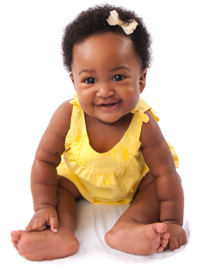
We come into the world with a moral foundation which helps us survive as individuals within a group. So our first priority is to know what group that is and who’s in it. Babies constantly have to distinguish between “Us” and “Them” and are primed to prefer “Us.” Newborns make distinctions between familiar and strange people almost immediately. Babies learn to use the rate at which they suck on a pacifier to control which voice they hear read a story: their mother’s or a stranger’s; and at less than three days old infants show a uniform preference for their mother’s voice. As babies develop, they quite naturally base their preferences, their adaptive biases, on the people around them: their own group.
A white child will tend to choose a black child with the same accent over a white child with a different accent.
It seems that we are born with the ability to judge who is “like me” and who isn’t: not in appearance, but in mind. Babies as young as seven months old prefer people who are like-minded – who, for example, might prefer Cheerios to graham crackers as they do – and they dislike those whose opinions differ. More than 80% of babies under a year old, and 100% of those a little over a year old continue to prefer like-minded individuals even when they appear to harm others who are not like them! It obviously had to be a priority for us to distinguish and prefer our own group from the start, and to be wary of outsiders.
Babies prefer to hear the language that is the most familiar to them, and young children tend to prefer a playmate who speaks their own language, which makes sense, since it is so much easier; but strangely there is also a bias not only towards the same language, but towards the same accent. Race plays no part in children’s choices: a white child will tend to choose a black child with the same accent over a white child with a different accent.
Our Moral Endowment: Four Capacities
The overwhelming majority of babies tested recognize and show preference for nice actions over mean actions.
According to Bloom our natural moral endowments include four capacities:
1. A moral sense – some capacity to distinguish between kind and cruel actions
Kindness to kin has been noted in many species of the animal world, and even in the plant world, because it quite obviously ensures the survival of parental and family genes: we take care of our own first. But, even in rats and certainly in our primate ancestors, acts of kindness have been seen to include others outside the immediate group, and even towards another species.
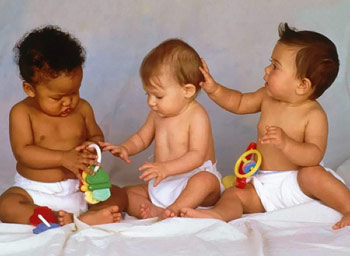
Unsurprisingly, infants’ sensitivity to “badness” is more powerful and emerges earlier than their sensitivity to “goodness.” It pays to be warned about a potential threat. Karen Wynn, director of the Yale Infant Cognition Center, also known as the baby lab, has run repeated experiments with 3- and 5-month-old children and established that the overwhelming majority of them – more than three-fourths of babies tested – recognize and show preference for nice actions over mean actions, leading them to prefer nice individuals over mean individuals. Just about all the 6- and 10-month-old infants prefer the helpful individual to the hindering individual. “Study after study after study, the results are always consistently showing that babies feeling positively towards helpful individuals in the world. And disapproving, disliking, maybe condemning individuals who are antisocial towards others,” she says.
Infants at the Yale Baby Lab are given a puppet show featuring a gray cat who attempts to open a big box but can’t. Along comes a bunny in a green T-shirt who helps kitty get into the box. The same scene is repeated only this time a bunny wearing an orange T-shirt rudely slams the box shut.
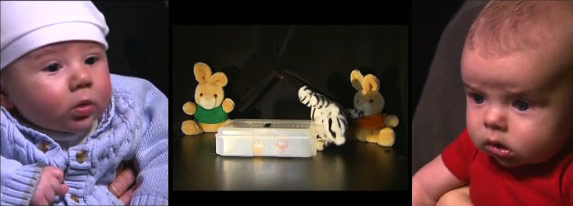
The conclusion: Green bunny is good. Orange bunny is bad. Then a staff member, who doesn’t know which bunny is good or bad, will present the bunnies to the baby. In over 80% of the responses, babies pick the good bunny. Surprisingly, in three-month olds the positive response bumps up to 87%.
Human babies are born with innate indiscriminate cooperative and helpful tendencies. As early as six months old, children begin to help spontaneously, and the degree that they do so goes up in the following years, but with friends and family, rarely with total strangers. A toddler of one or two years old will help a relative stranger open a door, for example, and do so without encouragement or praise – though it’s unlikely that he will do so for a complete stranger before the age of 4.
As early as six months old, children begin to help spontaneously.
Three-year-olds are more likely to help someone whom they have seen help others, and less likely to help someone who has been unkind to another person. They really are motivated by genuine care since they actually get involved in accomplishing the goals of the person they help, and act with that person’s interests in mind, not their own. For example, if asked to pass a cup so that someone can pour water in it, they will make sure that the cup is not damaged, even though it was previously selected by the experimenter.
2. A rudimentary sense of fairness – a tendency to favor equal divisions of resources
At fifteen months old, a child will look longer at an unfair division, suggesting that he/she found it surprising. (A control study ruled out the possibility that they just look longer at asymmetric displays.) By sixteen months, babies prefer a puppet who is seen to act fairly by dividing resources equally between two other puppets; at nineteen months old, when two toddlers clean up a room, they expect equal reward even if the effort was unequal. But, between six and eight years old, children amend their view of equal division if told that one person did more than another. Six- to eight- year-olds prefer to throw out an extra item rather than have one person get more than another, unless, again, the circumstances are explained and there is a justification for giving more to that person. If there is an odd number of resources and they don’t have the option of throwing one away, even three-year-olds will prefer to give more to siblings and friends than to strangers; or give the extra one to someone who they have previously seen act generously to a third person.

Although they are sensitive to inequality, children of five or six are just like our simian relatives – they get upset about it only when they are the ones getting less. In fact, they would rather get nothing than have another child, a stranger, get more than they do; and half of the young children tested of this age chose not to give away candy to strangers even if it costs them nothing. Interestingly, young children focus primarily on social comparison and routinely choose to get less for themselves from a number of options offered if this means getting more than the other party. However, once children are seven or eight years old, about 80% of them will give candy to someone they don’t know; by around 8 years old children tend to act fairly; and by 9 or 10 – by which time they have been acculturated and educated – they may deliberately give the other person more than they take themselves.
3. A rudimentary sense of justice – a desire to see good actions rewarded and bad actions punished
A number of studies indicate that babies not only have a sense of fairness but also a strong belief in punitive action when it’s deserved. For example, a bunny puppet steals a ball and runs away. But in the next scene this same bunny tries to open a box to get a toy, but another bunny slams the box shut and prevents him from doing so. 81% of babies preferred the bunny who “punished” the ball thief. “What we’re finding in the baby lab, is … that there’s a universal moral core that all humans share. The seeds of our understanding of justice, our understanding of right and wrong, are part of our biological nature,” says Paul Bloom. By eight months old, babies preferred a puppet who was mean to a “bad” puppet over the one who was nice to it.
…females tend to respond empathetically regardless of how they have been treated.
Bloom’s explorations led him to conclude that “We have evolved a tendency to retaliate against those who harm us and who harm the people we love because by doing so we deter such behavior in the future.” Because we empathize with others, we extend these sentiments to our larger community. Third-party punishment appears to be revenge plus empathy: “what would I want if I were the victim?” There appears to be an intimate connection between judging others and judging ourselves. We feel more guilt if we harm someone with whom we empathize and our empathy is biased towards those whom we perceive in a positive light. If someone treats us or our group badly, we will have no, or much less, empathy for him, particularly if we are male. It turns out that females tend to respond empathetically regardless of how they have been treated.
4. Empathy and compassion – suffering at the pain of those around us and the wish to make this pain go away
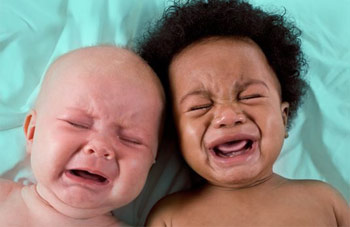
Babies will cry at the sound of another baby crying and can identify the difference between this and a computer-generated noise at the same volume or the cry of another species: say a chimpanzee. Animals, such as rats or monkeys, react to others of their species expressing distress and psychologists suggest that we all may have evolved to find another’s distress unpleasant – even sometimes overwhelming. This is described as “emotional contagion” and may indicate a basic feeling of empathy but does not mean that we feel compassion. We don’t necessarily care about a person but we still can empathize: we can put ourselves in that person’s shoes.
Even in the first year of life, babies show distress if they harm someone; and one- or two-year-old babies – particularly girls – will try to sooth someone in pain and to comfort someone in distress. Similar behavior in other primates has been noted by Frans de Waal and others. Additionally, Bloom suggests, over time altruism evolved because cooperative individuals were rewarded while those that go against the community were punished or avoided.
As mentioned, babies are aware of good and bad acts long before they are capable of acting themselves and it seems that we gradually develop a moral sense of self, which is manifested in guilt, shame and pride. Bloom quotes an experiment conducted by the psychologist Charlotte Buhler back in 1935, which demonstrated that one- and two-year-olds don’t immediately understand that a rule set by an adult applies once the adult leaves their sight. An adult and child were in a room together and the adult forbade the child to touch a toy, easily within reach. Once the adult leaves the room the child immediately plays with the toy. But when the adult suddenly returns, 60 percent of the sixteen-month-olds and 100 percent of the eighteen-month-olds “show the greatest embarrassment, blush, and turn to the adult with a frightened expression,” indicating that they do self-evaluate; and, in this instance, experienced some form of guilt or shame.
“Morality, then, is a synthesis of the biological and the cultural, of the unlearned, the discovered and the invented. Babies possess certain moral foundations — the capacity and willingness to judge the actions of others, some sense of justice, gut responses to altruism and nastiness. Regardless of how smart we are, if we didn’t start with this basic apparatus, we would be nothing more than amoral agents, ruthlessly driven to pursue our self-interest. But our capacities as babies are sharply limited. It is the insights of rational individuals that make a truly universal and unselfish morality something that our species can aspire to.” Paul Bloom, The Moral Life of Babies – New York Times Magazine.
How Strong are Our Ethical Stances?
The rise of social media has allowed misinformation about everything from politics to health, history to science to spread at unprecedented speed, raising concerns about the difficulty of distinguishing fact from fiction. Even when people initially recognize information as false, because it’s so often repeated, they may later mistake their familiarity with it as a sign of its truthfulness.
But that’s not all. It turns out that mere exposure to misinformation, perhaps especially in the form of vivid narratives such as “fake news” stories, may encourage people to imagine how it could have been true. As a result, even when people remember the misinformation as false, they may be more inclined to let public figures off the hook for asserting it as true.
Daniel A. Effron from the London Business School ran experiments clearly demonstrating that when a falsehood is told that aligns with our political preferences in a way that enables us to reflect on how it could have been true, we tend to judge the falsehood as less unethical to tell, and to judge the politician who told it as having a more moral character and deserving less punishment than when an equivalent falsehood is told by a politician who does not align with our political preferences. Similar results emerged independently in three studies, regardless of whether participants considered the same falsehoods or generated their own.
For example, Effron points out that to defend the false claim that more people attended Donald Trump’s inauguration than Barack Obama’s, spokespeople proposed the notion that Trump’s crowd would have been larger if the weather had been better (Rossoll, 2017). Or some people might justify Hillary Clinton’s false claim that no Trump-brand products are made in the United States by imagining they would have been made abroad if it had been cheaper to do so. These conditional propositions—if circumstances had been different, then an event would have occurred—are called counterfactuals. Logically, they do not render falsehoods true, but psychologically, they may make falsehoods seem less unethical.
Even when people are motivated to excuse a falsehood, they are unlikely to convince themselves it’s literally true, because facts can be checked. It is easier to convince oneself it could have been true. Counterfactuals cannot be falsified because history cannot be rerun to test what would have occurred in alternative circumstances. Thus, counterfactuals provide a degree of freedom people can exploit.
It turns out that our moral judgements depend not only on what actually is true but on what feels true to us. We are more likely to lie about achieving a goal, if we almost did so, than if we were nowhere close to doing so. We judge future events as more likely to occur when we imagine them, so leaders can reduce the negative consequences of telling a falsehood merely by convincing their supporters it could have been true.
For example, participants were more likely to lie about achieving a prizewinning die-roll when their actual roll was numerically close to the winning number. It seems participants felt it was less unethical to tell when the lie involved misreporting their roll by a small margin than a large margin.
Regardless of political views, participants condemned falsehoods. However, falsehoods supporting their views received less condemnation, particularly if they were counterfactuals. Supporters of a particular point of view, person or cause may not ignore facts, but may readily excuse a falsehood for which there is a justification, even a weak one. We should thus be wary of our ability to imagine alternatives to reality. When leaders we support encourage us to consider how their lies could have been true, we may hold them to laxer ethical standards.
Extending this further, it helps to explain why people believe cults/religious myths are literally true: they are aligned with beliefs and ideologies that as believers they are motivated to defend; they are predisposed to believe counterfactual stories, told as the truth, which are repeated and repeatedly imagined.
Moral Self-Licensing: When Being Good Frees Us to Be Bad
We are morally inconsistent in at least one other way as well. Studies show that past good deeds tend to liberate individuals to engage in behaviors that are immoral, unethical, or otherwise problematic — behaviors they would otherwise avoid for fear of feeling or appearing immoral. For example, individuals whose past good deeds are fresh in their mind often feel less compelled to give to charity than individuals without such comforting recollections.
Even recounting moral stories about oneself or engaging in moral behavior has the power to license immoral actions. Merely imagining helping others can have the same effect. In 2006 Professors Uzma Khan from Carnegie Mellon and Ravi Dhar from Yale, paid participants $2 for a study in which they imagined performing various activities and then were asked if they would donate any of their payment to a charity. Participants who imagined agreeing to help another student for a few hours donated less at the end of the experiment than people in the control condition who did not imagine doing anything generous. The conclusion is that because we view our own intentions as more indicative of our identity than we do our behavior, we allow ourselves to license less-than exemplary behavior.
In summary, thinking about one’s past moral behavior or merely expressing one’s generous intentions can license people to behave more selfishly than they would otherwise allow themselves to behave.
How About a “Nice Cup of Tea”?
Very early in childhood, before language abilities or memory retrieval skills appear, the infant learns about the physical world (e.g., distance, size, temperature) through direct concrete experiences. These physical experiences become associated with the infant’s emotional experience at the time. John Bowlby in his book Attachment and Loss argued that the need for both physical and social warmth across evolutionary time periods has resulted in an innate drive for the young of many species, including humans, to remain close to their parents and kin. Early childhood experiences with caretakers who provide warmth — both physical (holding close) and psychological (love, trust, help, support) — lead to the development of a strong associative connection between our perceptions of physical and social warmth. This assumed associative relation helps to explain the fact that we so easily and fluently use physical terms to refer to and describe more abstract phenomena – especially social and psychological phenomena, as in a “close” relationship, a “warm” smile, or a “higher calling”.
Studies show that physical and social warmth are inextricably linked and, because they are part of our self-regulatory system, affect our behavior unconsciously. Experiencing physical warmth like warm baths or showers or a warm drink will help to fight off loneliness or rejection. Such incidental warmth experiences produce in turn “warm” psychological experiences of trust and effect our behaviors, such as generosity, without our awareness. Holding a cup of warm coffee results in behavior that is more selfless and generous than when holding a cold or iced drink. When studies took place in either a cold or warm room, those participants in the warmer room reported feeling interpersonally closer to the experimenter than those in the colder room. Across all the studies, physical warmth led to judgments and behavior that were socially warm and the reverse.
When Emotions Overtake Morality

It’s important to realize that emotions can override moral actions, particularly when they are activated in a group situation. As individuals, once we adopt another’s perspective, we are more likely to favor that person over others; we might favor a suffering girl whose story we know ahead of everyone else waiting for care, rather than adhere to objective and fair procedures. Bloom suggests, therefore, that part of being a good person involves being able to override one’s compassion where necessary, rather than cultivate it.
We empathize most with those around us. Consequently, in a group situation, the beliefs and biases of the group tend to influence our behavior, often in ways that as an individual we might abhor. As Bloom notes “for every in-group there is an out-group, and that’s where the trouble lies. We would have no Holocaust without the Jews and Germans; no Rwandan massacre without the Tutsis and Hutus.” Since we are evolutionarily biased to belong in a group, we tend to create groups based on any number of reasons: age, sex, race, religion, or ethnicity among them; and sometimes for very trivial reasons like the color of a T-shirt. But even then our behavior within such groups can become extreme – as we know from the news – and you can be killed because your T-shirt is the “wrong” color.

In spring 1967, in Palo Alto, California, history teacher Ron Jones conducted an experiment with his class of 15-year-olds to sample the experience of the attraction and rise of the Nazis in Germany before World War II. In a matter of days the experiment began to get out of control, as those attracted to the movement became aggressive zealots and the rigid rules invited confusion and chaos, as the film based on the event shows.
We are endowed with a flexibility of mind that has enabled us not only to survive anywhere in the world, but to move beyond our inheritance. At the same time, as we have seen throughout our violent history, in a group situation, this same ability to adapt can quickly distort our innate morality and lead us to reprehensible behavior. As social psychologists have shown in a number of studies – especially in the work of Drs. Phil Zimbardo and Stanley Milgram – we are particularly vulnerable if the situation is institutionalized: if we, or someone, wear uniforms, there are implied or explicit official rules from above, etc. Described as a celebration of the human mind’s capacity to make any of us kind or cruel, caring or indifferent, creative or destructive, villains or heroes, the TED talk by Zimbardo graphically demonstrates this tendency, some of its recent consequences, its implications and solutions.
The power of the situation is revealed in many aspects of our society. Studies suggest that behavior is often influenced by factors that have less to do with altruistic and egalitarian motives and more to do with looking altruistic and egalitarian. In experiments or games where generosity is tested, the more observable one’s act is, the more one gives. Even pictures of eyes on a wall or computer screen make people kinder, behave more honorably.
This idea of “the other” watching or knowing what we do and think has been with us since at least Paleolithic times. It is inherent in the way we see the world: in our three-tiered consciousness. Upon this fundamental scaffold and paired with our inherent characteristics, religions, cultures and civilizations were built and their ideas transmitted.
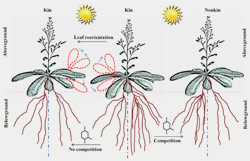
Shedding Light on Kin Recognition Response in Plants
Harsh P. Bias, New Phytologist
Kin recognition, an underpinning of our moral endowment, is a well understood phenomenon in animals and human babies. Now scientists are finding it in plants.
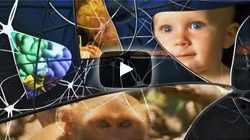
Watch: So Human, So Chimp
PBS Series, The Human Spark
Alan Alda explores how much of the “Human Spark” flared only since we evolved away from our non-human primate cousins, and how much was already there at the parting of the ways.
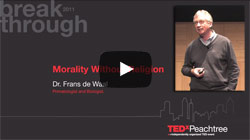
Watch: Morality Without Religion, TEDxPeachtree
Frans de Waal
“I am not sure that religion is at the root of morality because I personally think that morality existed before we had religions … all human societies have a form of religion so what does religion contribute to human society – that’s the question.”
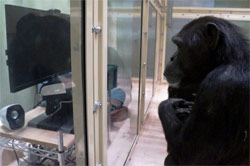
Chimps May Be Able to Comprehend the Minds of Others
Catherine Caruso, Scientific American
A gorilla-suit experiment reveals our closest animal relatives may possess “theory of mind”
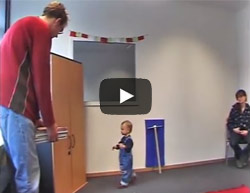
Watch: Experiments with altruism in children and chimps
Max Planck Institute for Evolutionary Anthropology
A series of experiments testing altruism in both very young children and chimpanzees.
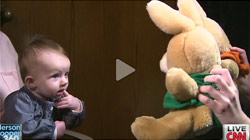
Watch: Are we born with a moral core? The Baby Lab says ‘yes’
CNN
Yale University researchers say babies are born with knowledge of right and wrong. A test with puppets shows babies preferring the “good” character most of the time.
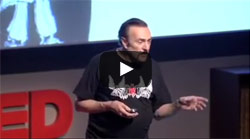
Watch: The psychology of evil | Philip Zimbardo
TED
Philip Zimbardo knows how easy it is for nice people to turn bad. In this talk, he shares insights and graphic unseen photos from the Abu Ghraib trials. Then he talks about the flip side: how easy it is to be a hero, and how we can rise to the challenge.
Featured Books

Social
Why Our Brains are Wired to Connect
Matthew D. Lieberman
Our need to connect with other people is even more fundamental, more basic, than our need for food or shelter. Understanding the neuro-cognitive functions underlying this need can help us rise to the unique challenges we face today.
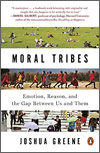
Moral Tribes
Emotion, Reason, and the Gap Between Us and Them
Joshua D. Greene
Our innate moral behavior evolved over millions of years to promote cooperation within our group. Each group has its own moral code, which provides a map for how individuals can live successfully within it. Our other innate tendency, to favor our group over all others, is something we need to understand and mitigate to address the existential challenges of our modern global society.
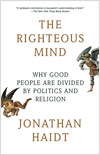
The Righteous Mind
Why Good People Are Divided by Politics and Religion
Jonanthan Haidt; reviewed by John Zada
We are without doubt living in an era of polarised thinking, marked by much bickering across social and political lines. But could positions of both side have roots in common moral foundations?
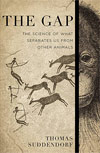
The Gap
The Science of What Separates Us from Other Animals
Thomas Suddendorf
A leading research psychologist concludes that our abilities surpass those of animals because our minds evolved two overarching qualities: our drive to understand one another and our ability to image different possible futures.
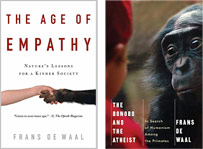
The Age of Empathy
and
The Bonobo and the Atheist
Frans de Waal
Both reciprocity and empathy – the two pillars upon which morality is built – are found in bonobos, apes and other social animals. But only humans are able to “abstract” the value and extend the behavioral constraints of “one-on-one” morality to the larger society, including strangers. Rather than being in conflict, both religion and the scientific pursuit of knowledge are motivated by a similar inspiration to find meaning and a sense of purpose.
